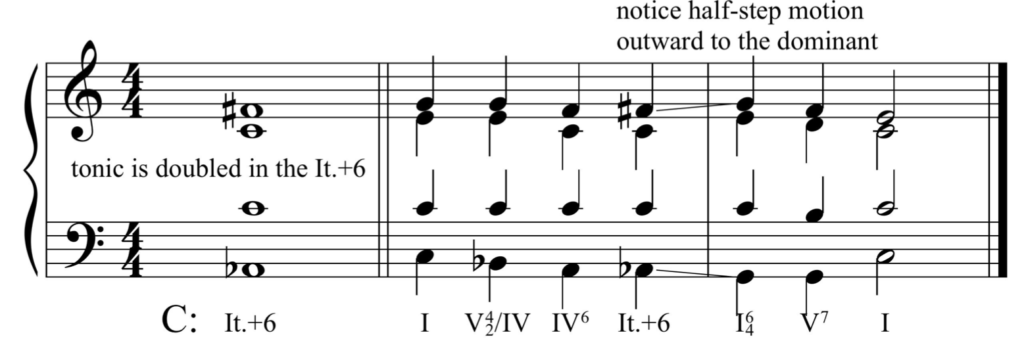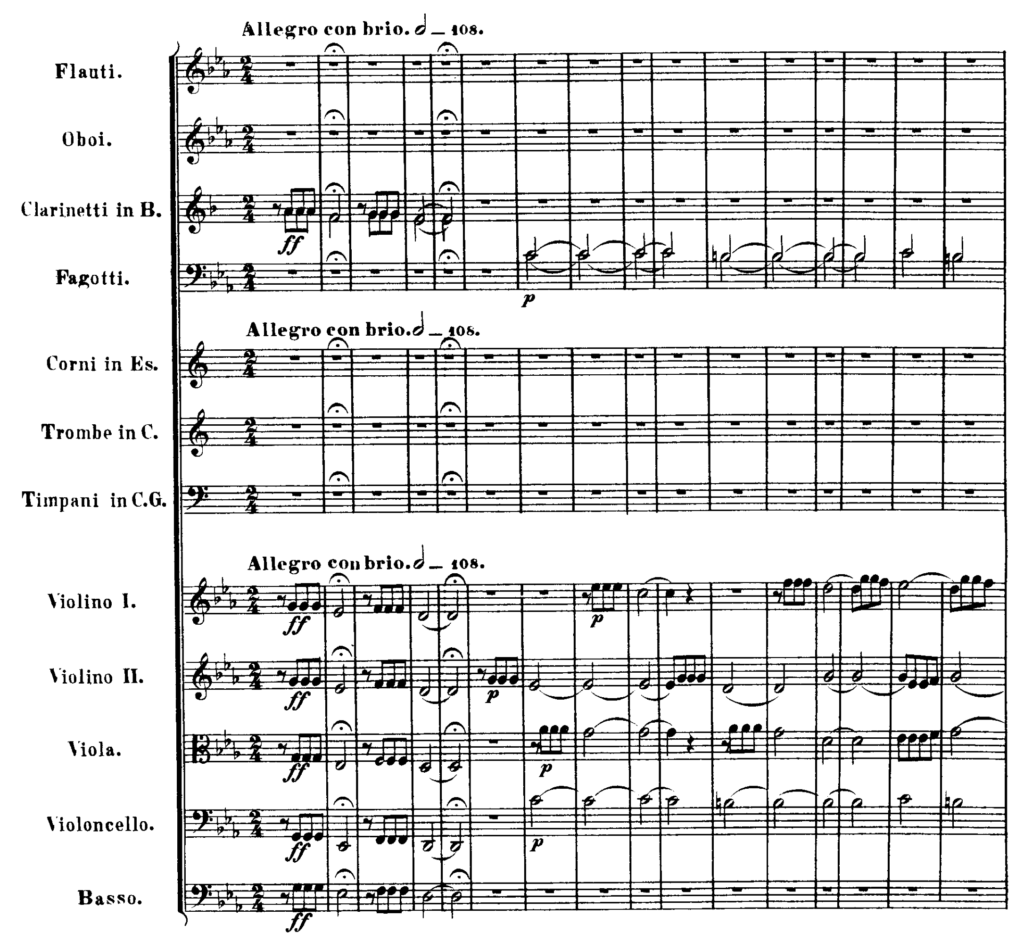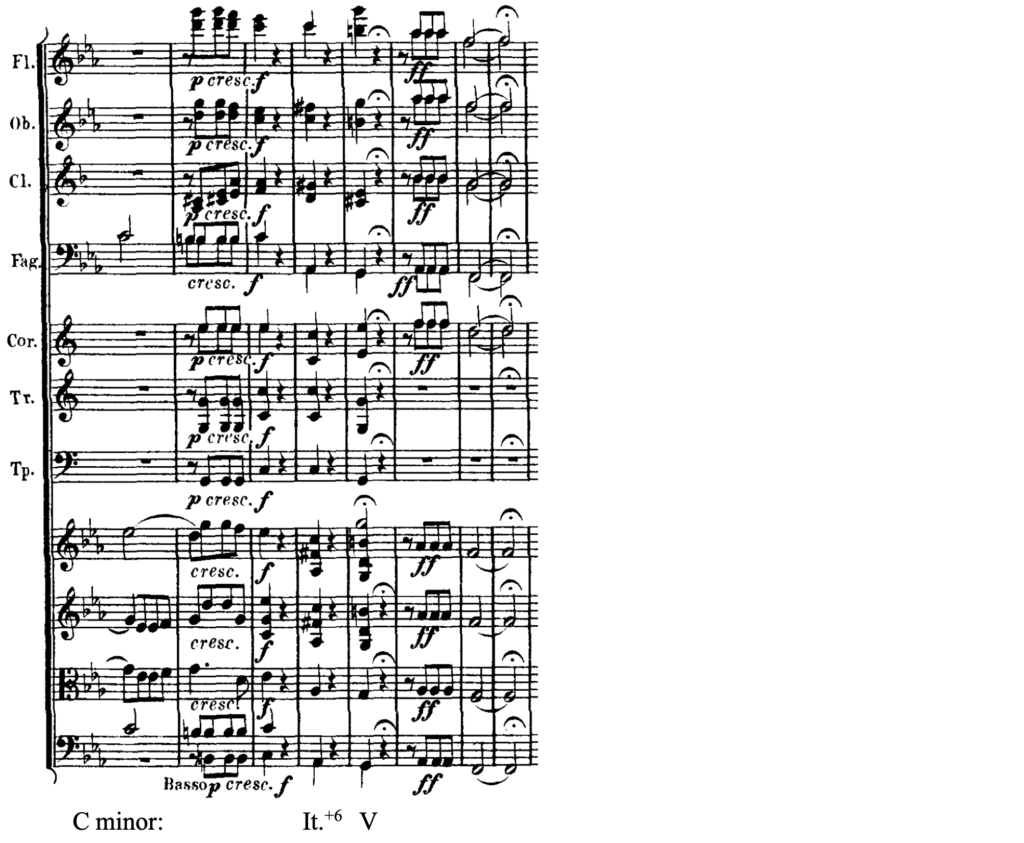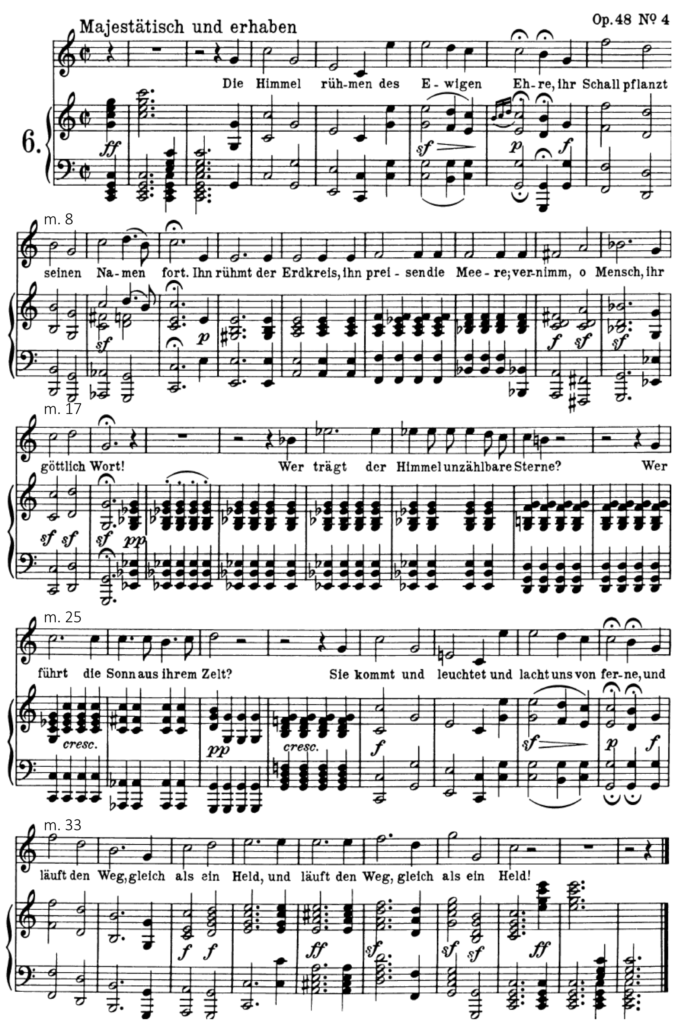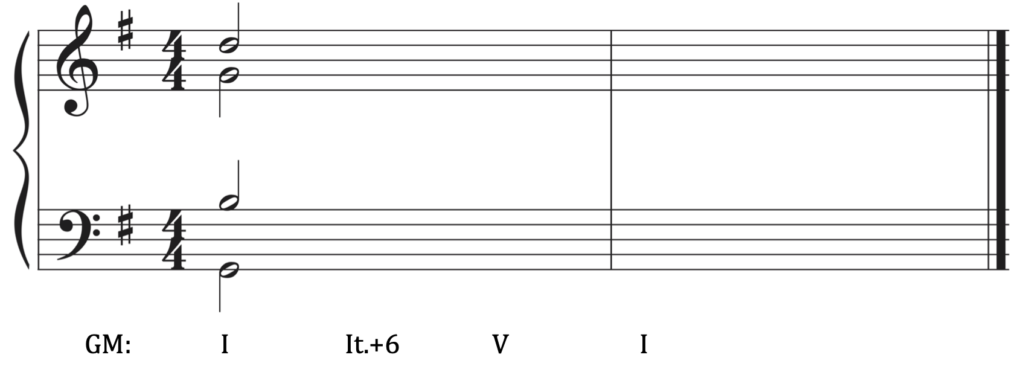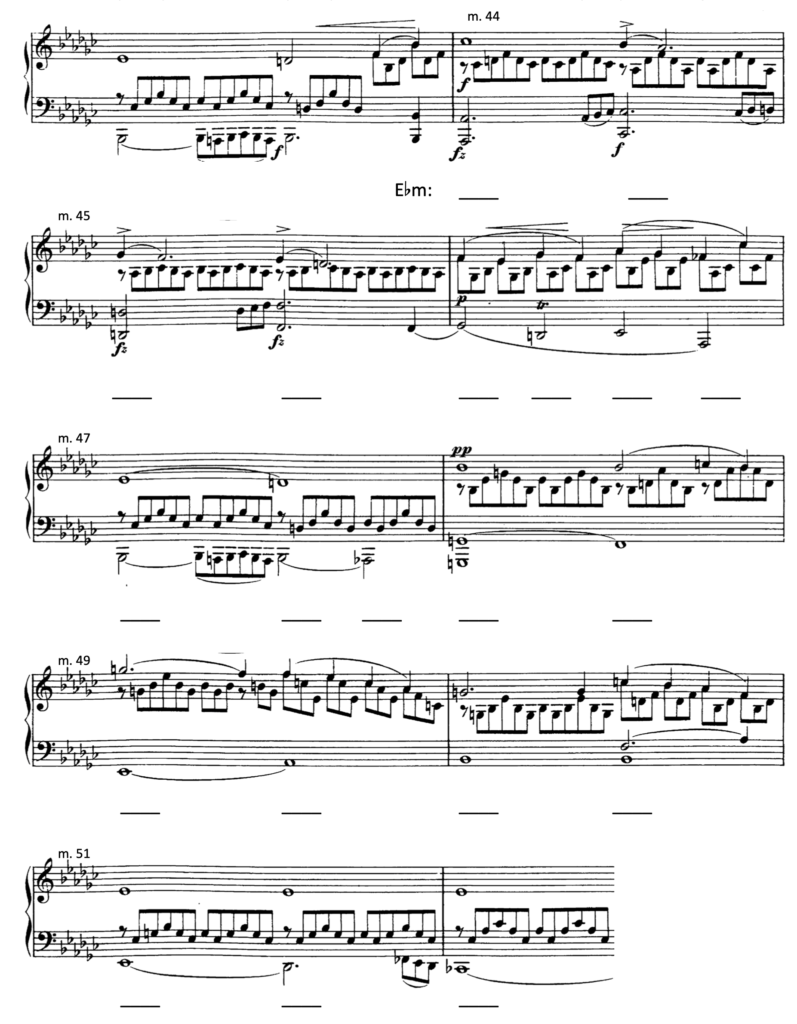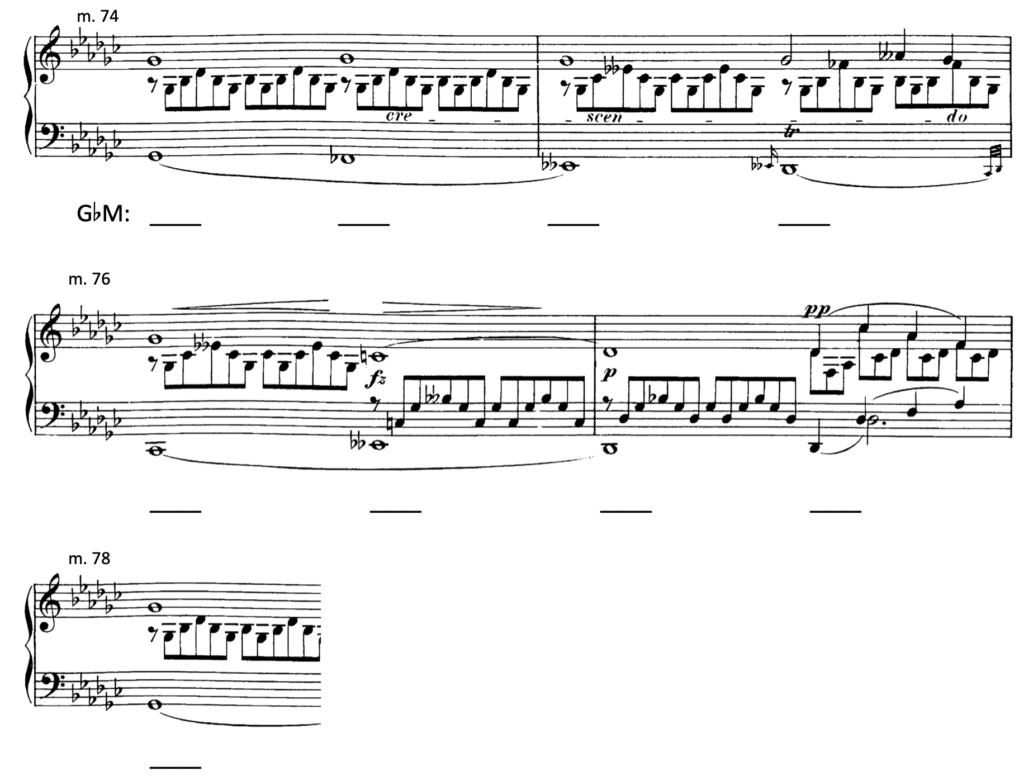Main Body
42 Augmented sixth chords
Learning goals for Chapter 42
In this chapter, we will learn:
- The properties of
- How to spell augmented sixth chords
- Best practices for voice leading augmented sixth chords
- How augmented sixth chords function in musical contexts
Augmented sixth chords
Like the chord, (+6 chords) are striking predominant chords. Augmented sixth chords result from chromatic voice leading and intensify the approach to the dominant by using linear half-step motion. Because of their linear nature, augmented sixth chords have no root or true inversional properties, in contrast to other chords we have studied. In this chapter, we will approach their function and labeling from a linear perspective.
There are three varieties of augmented sixth chords: the Italian, the German, and the French. All three feature scale degrees ![]() (“le”),
(“le”), ![]() (“do”), and
(“do”), and ![]() (“fi”). The interval of an augmented sixth is formed between
(“fi”). The interval of an augmented sixth is formed between ![]() (“le”) and
(“le”) and ![]() (“fi”), hence the name of the chord. In minor keys,
(“fi”), hence the name of the chord. In minor keys, ![]() (“le”) is already lowered, but in major keys the submediant needs to be lowered by one half step.
(“le”) is already lowered, but in major keys the submediant needs to be lowered by one half step.
The is the simplest of the three types, containing only the three scale degrees described above—![]() (“le”),
(“le”), ![]() (“do”), and
(“do”), and ![]() (“fi”)—and it sounds like an incomplete major-minor seventh chord. Example 42-1 summarizes the properties, function, and voice leading of the Italian +6.
(“fi”)—and it sounds like an incomplete major-minor seventh chord. Example 42-1 summarizes the properties, function, and voice leading of the Italian +6.
Video: T77 +6 video 1: The basics
This video introduces the idea of the chord in relation to its enharmonic equivalent, the incomplete V7.
The contains four scale degrees—![]() (“le”),
(“le”), ![]() (“do”),
(“do”), ![]() (“me”) and
(“me”) and ![]() (“fi”)—and sounds similar to a complete major-minor seventh chord. When spelling the Ger.+6 in minor keys,
(“fi”)—and sounds similar to a complete major-minor seventh chord. When spelling the Ger.+6 in minor keys, ![]() (“le”) and
(“le”) and ![]() (“me”) are already in their lowered forms. In major keys, you must lower scale degrees
(“me”) are already in their lowered forms. In major keys, you must lower scale degrees ![]() (“la” becomes “le”) and
(“la” becomes “le”) and ![]() (“mi” becomes “me”) by a chromatic half step in order to spell the lowered versions of these scale degrees correctly. Example 42-2 summarizes the properties, function, and voice leading of the German +6.
(“mi” becomes “me”) by a chromatic half step in order to spell the lowered versions of these scale degrees correctly. Example 42-2 summarizes the properties, function, and voice leading of the German +6.
Sometimes the Ger.+6 is spelled with ![]() (“ri”) instead of
(“ri”) instead of ![]() (“me”) when it precedes a chord. This is because
(“me”) when it precedes a chord. This is because ![]() (“ri”) acts like a chromatic tendency tone to
(“ri”) acts like a chromatic tendency tone to ![]() (“mi”), as
(“mi”), as ![]() (“fi”) is a secondary leading tone to
(“fi”) is a secondary leading tone to ![]() (“sol”).
(“sol”).
German augmented sixth chords and complete major-minor seventh chords are like homophones in English—they sound the same, but are spelled differently (just like “sail” and “sale,” for example). In music, this phenomenon is called . Augmented sixth chords and major-minor seventh chords also have different functions in musical phrases: the former are predominant chords, whereas the latter function dominantly.
The uses ![]() (“le”),
(“le”), ![]() (“do”),
(“do”), ![]() (“re”), and
(“re”), and ![]() (“fi”), a subset of the . Unlike the It.+6 and Ger.+6, the French +6 is not enharmonically equivalent to a major-minor seventh chord. Like with both the It.+6 and Ger.+6, in minor keys,
(“fi”), a subset of the . Unlike the It.+6 and Ger.+6, the French +6 is not enharmonically equivalent to a major-minor seventh chord. Like with both the It.+6 and Ger.+6, in minor keys, ![]() (“le”) is already in its lowered form, and in major keys, you must lower it by a chromatic half step in order to spell
(“le”) is already in its lowered form, and in major keys, you must lower it by a chromatic half step in order to spell ![]() (“le”). Example 42-3 summarizes the properties, function, and voice leading of the French +6.
(“le”). Example 42-3 summarizes the properties, function, and voice leading of the French +6.
Video: T78 +6 video 2: The three types
This video demonstrates how to spell each of the three types of and shows a brief progression of their use in C major.
EXERCISE 42-1 Spelling +6 chords
On a separate sheet of staff paper, provide key signatures for each problem and spell the augmented sixth chord. Remember that in minor keys, the only chromatic note is scale degree ![]() (“fi”). In major keys, scale degrees
(“fi”). In major keys, scale degrees ![]() and
and ![]() must be lowered by a half step, in addition to raising scale degree
must be lowered by a half step, in addition to raising scale degree ![]() .
.
Augmented sixth chords in context
The first movement of Beethoven’s famous Fifth Symphony features an exciting appearance by the Italian augmented sixth. Study and listen to Example 42-4, which presents an excerpt from the beginning of the movement. The Italian augmented sixth chord occurs in the second system, preceding the dominant in the key of C minor.
Example 42‑4. Ludwig van Beethoven, Symphony no. 5, mvt. 1, mm. 1–21
Listen to the full track, performed by the Vienna Philharmonic Orchestra conducted by Wilhelm Furtwängler, on Spotify.
Learn about German composer Ludwig van Beethoven (1770–1827) by reading this Oxford Music Online article, written by Joseph Kerman and others.
EXERCISE 42-2 Analysis with augmented sixth chords
After studying the score and listening to Worksheet example 42‑1, complete the tasks and answer the questions below. If you’re stuck, the video following the exercise may help you get started.
- Identify the overall key.
- The augmented sixth appears twice. In which measures does it appear?
- Which kind of augmented sixth is used? Select one: It.+6 Ger.+6 Fr.+6
- Provide the most logical Roman numeral labels for the following measures:
m. 11 _____
m. 12 _____
m. 13 _____
m. 14 _____
m. 37 _____
m. 38 _____ - A unfolds in mm. 11–14. What is the root motion pattern involved in this sequence?
- Provide a lead-sheet (chord) symbol for the chord in m. 10.
- Provide a lead-sheet (chord) symbol for the chord in m. 11.
- What term (two words) best describes the relationship between the chords in m. 10 and m. 11?
- What key area is implied in mm. 1–10?
- What (temporary key area) is implied in mm. 19–22?
- What term (two words) best describes the relationship between the key areas in mm. 1–10 and mm. 19–22?
- In several sentences, describe two uses of in this song.
Worksheet example 42‑1. Ludwig van Beethoven, op. 48, no. 4, “Die Ehre Gottes aus der Natur”
Listen to a recording of the song, performed by Matthias Goerne, on Spotify.
Read an English translation of the song text, by Emily Ezust, on lieder.net.
Learn about German composer Ludwig van Beethoven (1770–1827) by reading this Oxford Music Online article, written by Joseph Kerman and others.
Video: T79 +6 video 3: analysis (3:41)
This video illustrates Beethoven’s use of the It. +6 in op. 48, no. 4, “Die Ehre Gottes aus der Natur” (Worksheet example 42-1). If you are stuck with Exercise 42-2, this video may help you get started.
Aural identification of augmented sixth chords
Now that we have learned many different types of chromatic predominantly functioning chords, developing the ability to discern these by ear will help us further solidify our understanding of each and enhance our musicianship skills. The exercises that follow will help you develop skills to identify augmented sixth chords and other predominant chords we’ve studied.
EXERCISE 42-3 Contextual listening with augmented sixth chords
First, access the playlist here: Spotify playlist for augmented sixth chords
Choose a track, and play a portion of it. Pause the recording or sing over it, and find tonic (“do”) with your voice or an instrument. Sing scalar patterns to find “fi” (a tritone away from “do”) and “le” (![]() ). Continue listening to see if you can identify where the augmented sixth chord takes place, as it will feature these prominent scale degrees. If you get stuck, look up the track timing on the answer key and listen again to the excerpt, cued up to the appropriate spot. The playlist also contains some of the pieces we have already studied in this chapter. It may be helpful to review those first before trying new examples.
). Continue listening to see if you can identify where the augmented sixth chord takes place, as it will feature these prominent scale degrees. If you get stuck, look up the track timing on the answer key and listen again to the excerpt, cued up to the appropriate spot. The playlist also contains some of the pieces we have already studied in this chapter. It may be helpful to review those first before trying new examples.
Once you have found the augmented sixth chord, check your answer with the key here: Answers to EXERCISE 42.3 Contextual listening with augmented sixth chords
EXERCISE 42-4 Aural ID of predominant chords
In this exercise, you will hear a set of progressions, each containing five chords. Each progression features tonic, predominant, cadential six-four, five, tonic in succession. Your task is to identify the mode of each example (major or minor) and the best label for the second chord, which will be one of the predominant functioning chords we have studied. In major keys, the choices will include IV, ii![]() , V
, V![]() /V, N6, Ger.+6, and Fr.+6. In minor keys, the choices will include iv, iiø
/V, N6, Ger.+6, and Fr.+6. In minor keys, the choices will include iv, iiø![]() , V
, V![]() /V, N6, Ger.+6, and Fr.+6. Each progression will be played twice.
/V, N6, Ger.+6, and Fr.+6. Each progression will be played twice.
After you’ve completed a set, you can check your answers here: Answers to EXERCISE 42.4 Aural ID of predominant chords.
Set 1
Set 2
Set 3
Set 4
Set 5
Set 6
EXERCISE 42-5 Harmonic dictation with chromatic predominant chords
For this exercise, play the recording of each dictation up to four times. Your tasks are to notate the bass and soprano voices on staff paper, provide Roman numeral labels beneath the staff, and identify the cadence type at the end of the progression. Each progression will feature at least one chromatic chord we have studied.
Progression 1
Progression 2
Progression 3
Progression 4
Progression 5
EXERCISE 42-6 Contextual listening and transcription with +6
Listen to the excerpt. On a separate sheet of staff paper using the format below, notate the outer voices you hear, provide a Roman numeral analysis, label the cadence, and answer the questions that follow.
- In a sentence or two, describe the voice leading in this example.
- Who is a likely composer of this piece?
- When was this piece written, most likely?
Want more of a challenge? Notate all four parts on the staves below. Add dynamics and bowing articulations as well.
Voice leading with augmented sixth chords
Video: T80 +6 video 4: Voice leading (4:41)
This video demonstrates the basic voice leading connections between each augmented sixth chord and V. Spoiler alert: The doesn’t go immediately to V, but instead goes to the first. Watch the video or continue reading to find out why.
The principles of resolving augmented sixth chords are fairly straightforward. First, resolve the interval of the augmented sixth outward to an octave. To do this:
- The bass (
 or “le”) resolves down by step to scale degree
or “le”) resolves down by step to scale degree  (“sol”)
(“sol”) - The voice containing
 (“fi”) resolves up by step to scale degree
(“fi”) resolves up by step to scale degree  (“sol”)
(“sol”)
The voice that contains tonic (“do”) should move by step to the leading tone (“ti”). If the augmented sixth chord moves to a prior to resolving to the dominant chord, this voice will stay on tonic until it moves to the dominant chord. If there is more than one voice on scale degree ![]() (“do”), as in the chord in a four-voice texture, move one voice from scale degree
(“do”), as in the chord in a four-voice texture, move one voice from scale degree ![]() (“do”) by step to
(“do”) by step to ![]() (“ti”) and the other from scale degree
(“ti”) and the other from scale degree ![]() (“do”) to
(“do”) to ![]() (“re”).
(“re”).
The voice containing scale degree ![]() (“re”) in a chord will stay on scale degree
(“re”) in a chord will stay on scale degree ![]() when connecting to the dominant chord.
when connecting to the dominant chord.
In general, chords will pass through a cadential six-four before moving to the dominant in order to avoid pesky parallel fifths. In minor keys, this means that the voice containing scale degree ![]() (“me”) will stay on
(“me”) will stay on ![]() (“me”) before resolving down to scale degree
(“me”) before resolving down to scale degree ![]() (“re”). In major keys, we sometimes see an enharmonic spelling of the German augmented sixth chord, using
(“re”). In major keys, we sometimes see an enharmonic spelling of the German augmented sixth chord, using ![]() (“ri”) instead of
(“ri”) instead of ![]() (“me”). Regardless of the spelling, this voice will move to scale degree
(“me”). Regardless of the spelling, this voice will move to scale degree ![]() (“mi”) for the cadential six-four before moving down by step to scale degree
(“mi”) for the cadential six-four before moving down by step to scale degree ![]() (“re”) as the fifth of the dominant chord.
(“re”) as the fifth of the dominant chord.
EXERCISE 42-7 Voice leading with +6 chords
Given the Roman numerals, complete each passage for four voices () following the guidelines for part writing we have studied.
(1)
(2)
(3)
Additional analysis
EXERCISE 42-8 Analysis with N6 and +6 chords
PART 1. Study and listen to the following excerpt, and complete a Roman numeral analysis on the blanks beneath the staff. Circle all non-chord tones that appear in the melody. Be on the lookout for all of our favorite chromatic friends—secondary dominants, borrowed chords, Neapolitan sixths, and augmented sixth chords. Then answer the questions below.
- What do the four chords in mm. 44–45 all have in common?
- Describe how Schubert uses in this example.
Worksheet example 42‑2. Franz Schubert, Impromptu in G![]() major, op. 90, no. 3, mm. 43–52
major, op. 90, no. 3, mm. 43–52
Listen to the full track, performed by Alfred Brendel, on Spotify.
Learn about Austrian composer Franz Schubert (1797–1828) by reading this Oxford Music Online article, written by Maurice J. E. Brown and others.
PART 2. Study and listen to the following excerpt from the same piece, and complete a Roman numeral analysis on the blanks beneath the staff. Circle all non-chord tones that appear in the melody. Then answer the questions below.
- Describe how Schubert uses in this example.
- Consider the voice leading of the second chord in m. 76. Does this chord resolve in the way you expect it to? If so, what aspects of the voice leading conform to your expectations? If not, why not?
Worksheet example 42‑3. Franz Schubert, Impromptu in G![]() major, op. 90, no. 3, mm. 74–78
major, op. 90, no. 3, mm. 74–78
Listen to the full track, performed by Alfred Brendel, on Spotify.
Learn about Austrian composer Franz Schubert (1797–1828) by reading this Oxford Music Online article, written by Maurice J. E. Brown and others.
Supplemental resources for Chapter 42
Primer video on augmented sixth chords (Dry Erased Theory)
Dr. Kati Meyer’s video with musical examples and practice problems
Detailed video on augmented sixth chords (Dr. C’s Music Theory Land)
predominant chord resulting from chromatic voice leading that intensifies the approach to the dominant by using half-step motion; all augmented sixth chords contain an augmented sixth interval between scale degrees flat-6 ("le") and sharp-4 ("fi")
striking major triad with predominant function built off the root of lowered scale degree 2 (“ra”), most often found in first inversion
type of augmented sixth chord containing scale degrees flat-6, 1, and sharp-4; abbreviated as "It.+6"
type of augmented sixth chord containing scale degrees flat-6, 1, flat-3, and sharp-4; abbreviated as "Ger.+6"
type of second inversion triad that has scale degree 5 in the bass and resolves to a dominant chord, extending dominant function, usually at a cadence
term referring to two notes, intervals, or chords that sound the same, but are spelled differently
type of augmented sixth chord containing scale degrees flat-6, 1, 2, and sharp-4; abbreviated as "Fr.+6"
scale consisting of whole steps exclusively
process in which a repeating pattern of root motion appears in a harmonic progression
short passage of music in a new key, longer than a tonicization but not a full modulation
use of chromatic chords that exist diatonically in the parallel major or minor mode
abbreviation for four-voice music, referring to soprano, alto, tenor, bass; may apply to choral music or instrumental music in four parts
